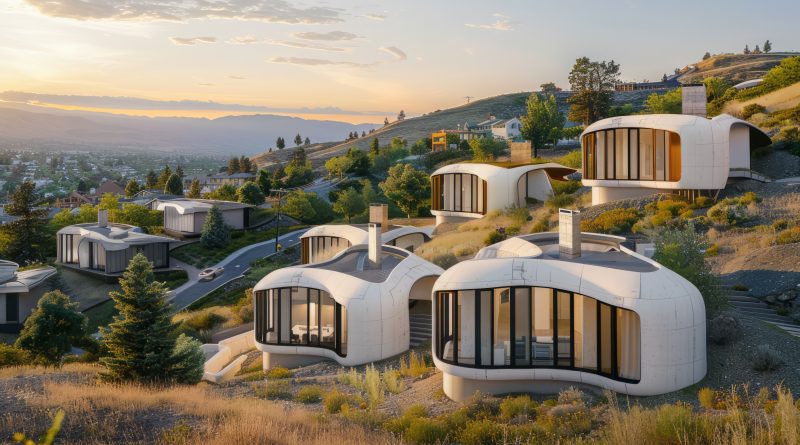Revolutionizing Construction: 10 Ways 3D Printing is Changing Homes
The dream of owning a home is evolving with the progression of technology, and one of the most groundbreaking developments in the construction industry today is 3D-printed housing. This innovative approach not only challenges traditional building techniques but also promises a future where homes can be constructed faster, cheaper, and more sustainably. The advent of 3D printing technology in construction offers a glimpse into a future where architectural designs are not constrained by traditional methods, and where entire communities can be built with reduced labor, cost, and environmental impact.
1. The Concept of 3D-Printed Homes
3D printing technology is revolutionizing the construction industry by enabling the building of homes using large-scale printers that layer materials based on digital designs. This method allows for precise and rapid construction of complex structures, often using concrete or composite materials. The technology not only simplifies the building process but also significantly reduces labor and material costs, making it a pivotal innovation in modern housing development.
2. Pioneering Projects Around the Globe
From the United States to Dubai, 3D-printed homes are setting benchmarks for future constructions. The U.S. saw its first fully 3D-printed home unveiled in 2018 in Austin, Texas, where a 650 square-foot house was constructed for approximately $10,000. Meanwhile, Dubai, known for its ambitious architectural projects, is pushing the envelope with plans to have 25% of its buildings constructed through 3D printing by 2030. These projects not only highlight the practical applications of 3D printing in construction but also its potential to redefine urban development globally.
3. Breakthroughs in Speed and Efficiency
The speed of constructing a 3D-printed home can be astonishing. For example, a project in Germany used the largest 3D printer configuration to date and estimated the construction time of a building at just 140 hours, showcasing the efficiency of this technology. Another remarkable instance is a house in the Netherlands, which reduced the typical construction timeline significantly, proving that entire homes can be built from the ground up in a matter of days, not months.
4. Cost-Effectiveness and Affordability
3D-printed homes are gaining traction not just for their technological innovation but also for their potential to drastically cut costs. The affordability of 3D-printed houses comes from significantly reduced labor costs and the efficient use of materials. For instance, a house in Austin was constructed at a cost of roughly $10,000, underscoring the financial benefits of this technology in creating affordable housing solutions. Similarly, the advancements in printer technology that allow for rapid construction also contribute to cost savings, as seen in the efficiency of project timelines that skip traditional building methods.
5. Sustainable Building Practices
Sustainability is at the core of the 3D-printing revolution in construction. The process minimizes waste by using the exact amount of material required, cutting down on the environmental footprint commonly associated with traditional construction methods. For example, a project showcased how 3D printing could reduce overall construction waste significantly, contributing positively towards more eco-friendly building practices. Additionally, the materials used in 3D printing, such as recycled plastics or composite materials, can further enhance the environmental appeal of this method.
6. Design Flexibility and Innovation
One of the most exciting aspects of 3D-printed homes is the unparalleled design flexibility they offer. Architects and designers can create structures with unique shapes and features that would be difficult or impossible to achieve with traditional construction methods. This has been demonstrated in projects like the 3D-printed concrete house in the Netherlands, where architects took advantage of digital modeling to realize intricate designs and innovative architectural forms. Furthermore, the integration of BIM (Building Information Modeling) and other digital tools enhances the ability to plan and visualize architectural projects in greater detail before they are printed, enabling a more creative and experimental approach to housing design.
7. Challenges and Limitations
Despite the promising potential of 3D-printed houses, several challenges impede their widespread adoption. Regulatory hurdles are significant, with many existing building codes not yet adapted to accommodate this innovative technology. Additionally, the durability and public perception of 3D-printed houses as inferior to traditional constructions pose barriers. Technical limitations also exist, including the need for skilled operators to manage the sophisticated 3D printing machinery and the challenge of printing under varied environmental conditions, which can affect the structural integrity of the printed buildings.
8. Social and Economic Impact
The social and economic implications of 3D-printed homes are profound. By reducing the cost and time required to build homes, 3D printing technology has the potential to significantly address homelessness and housing shortages, particularly in low-income communities. Projects like the one in Southern Mexico, where 50 homes were constructed for a poverty-stricken community, demonstrate how 3D printing can provide robust housing solutions quickly and affordably. This technology not only fosters social inclusion but also stimulates economic development by creating new jobs in tech-driven construction and reducing dependency on traditional labor-intensive building methods.
9. Future Technologies and Integration
The future of 3D-printed homes looks to integrate with other cutting-edge technologies, enhancing their functionality and appeal. Innovations such as artificial intelligence and smart home systems are expected to be integrated into 3D-printed buildings, offering automated environment control, energy management, and enhanced living experiences. The continued evolution of materials and printing technologies also promises to improve the quality, resilience, and aesthetic diversity of 3D-printed homes, making them more appealing to a broader market.
10. What’s Next for 3D-Printed Housing?
As 3D printing technology continues to evolve, the possibilities for its application in housing are boundless. Urban planners and policymakers are increasingly recognizing the potential of 3D printing in reshaping cityscapes, with projects aimed at increasing the scalability of this technology to build entire communities. Looking forward, the focus will likely shift towards improving the integration of utilities, ensuring compliance with international building standards, and enhancing the livability of 3D-printed structures to meet the dynamic needs of future residents.
Sources:
https://builtin.com/articles/3d-printed-house
https://modularhomesource.com/a-comprehensive-guide-to-3d-printed-homes/
